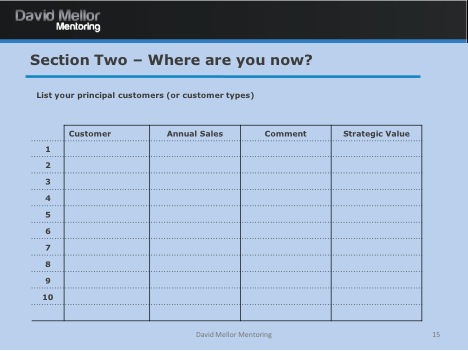#5: Taking stock
So you recognise that things have got to change. But where do you begin? A good way to start is by taking stock of where you are.
You may want to start with some relatively generic questions:
- How do we define what we do?
- What do we excel at?
- What do our customers value?
- What is our reputation?
- Who are our customers?
- How do we define success?
- What measurements of success do we use?
Then you could move on to take a high-level look at your headline financials, in particular the trend over the last 3 years in turnover, profit before tax, and cashflow. In terms of turnover and profit, how did your results compare to your forecasts, and do you understand the reasons for any gaps between what you expected to happen and what actually happened? In terms of cashflow, how did you fare managing your creditors and debtors?
Next would come a review of your products or services. You may want to create a little table like the one below, which will help you with your analysis. This may in due course force some hard decisions about which parts of the portfolio you keep, and which you downscale or discontinue.
It would be helpful to adopt the same procedure for your customers. Again, the table below may help you do this. One additional aspect you may want to consider is how profitable you think each customer is, bearing in mind your biggest client is not necessarily your most profitable. Are there any trends to analyse as far as client winning and client retention is concerned? Furthermore, did you receive any testimonials from happy clients, and did you have to deal with any complaints?
There are four areas left to consider:
- Firstly, if you have any staff, how successful have you been at hiring the right people? Are you comfortable with the interview process? What is the trend in staff turnover? Also, how would you fare in an HR Audit – would you be HR best practice, HR compliant, or worse…!
- Secondly, who are you dependent on in terms of external suppliers, service-providers and associates; how strategically important are they to you, and how well are they performing for you? Again, this could prompt some decisions.
- Thirdly, who are your competitors, and how do you stack up against them? What strengths do they have that you can learn from, and what weaknesses do they have that you can exploit?
- Finally, what lessons have you learned on your journey to date? Based on these lessons, what can you keep the same and/or develop, and what do you need to change, start or stop? It may help you to do this using a SWOT analysis – what are the top 5 Strengths, Weaknesses, Opportunities and Threats in your business, and what action should you contemplate based on the analysis? How good you are at Marketing and Sales might feature here.
Armed with this information you are well-placed to consider next steps, which begin with what you actually want to achieve and where you want to take the business.
Posted in: Growing Businesses
Leave a Comment (0) ↓

